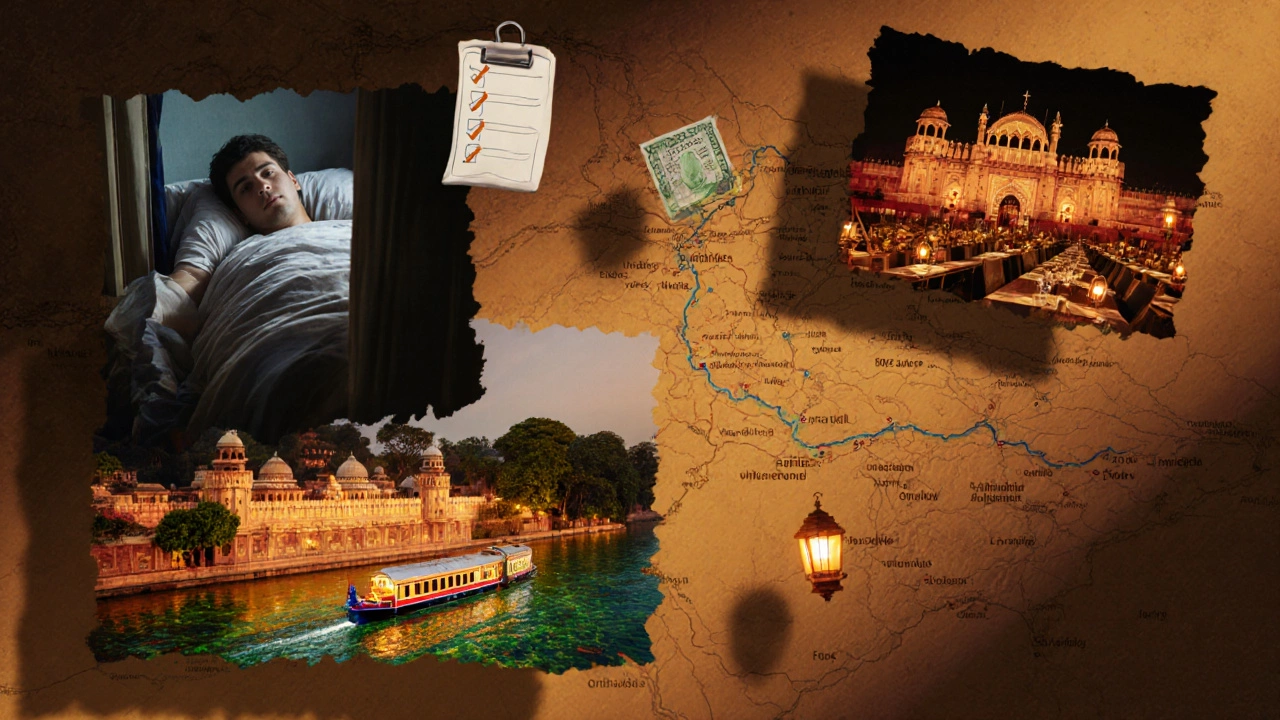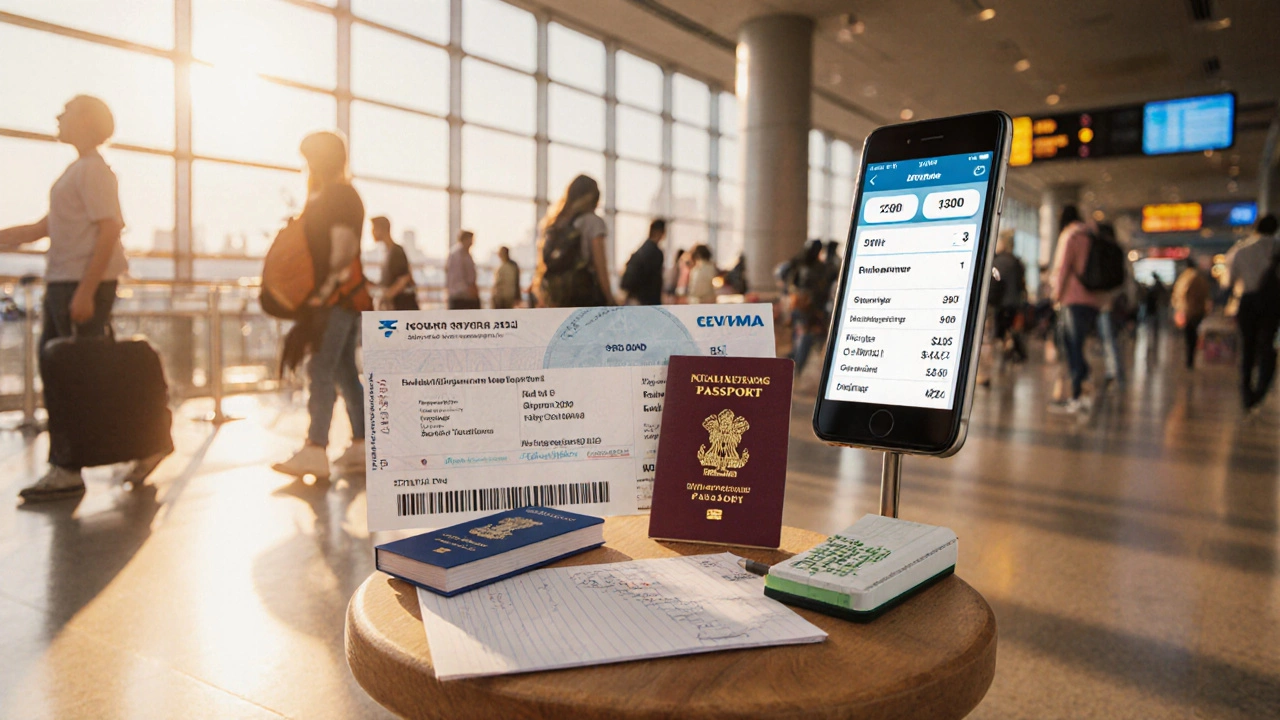India Travel Budget Calculator
Plan Your India Trip Budget
Your Estimated Budget
$0.00
Breakdown
Your Selected Regions
Pro tip: Traveling during off-season (October-November, February-March) can reduce costs by 20-30%. Consider using night trains to save on accommodation.
Quick takeaways
- Backpackers can manage on $25‑$35 USD per day.
- Mid‑range comfort sits at $50‑$80 USD daily.
- Luxury‑level trips start around $150 USD per day.
- Visa, insurance, and international flights are the biggest upfront costs.
- Smart choices on transport and food can shave 30‑40% off any budget.
What makes up the total cost?
When you ask, "How much money do I need for India?", the answer breaks down into three buckets: pre‑trip expenses, daily spend, and buffer for surprises. Pre‑trip costs include the flight, visa, travel insurance, and any required vaccinations. Daily spend covers accommodation, food, local transport, entry fees, and optional activities. A buffer-roughly 10‑15% of the total-helps you stay stress‑free if a train is delayed or you decide to splurge on a rooftop dinner.
Pre‑trip expenses you can’t avoid
Even the most frugal traveler has to budget for a few fixed items before stepping foot in India.
- International flight: From Europe or North America, round‑trip tickets range $600‑$1,200 USD depending on season and how early you book.
- Visa fee: E‑Visa for tourism costs $10‑$25 USD for stays up to 60 days.
- Travel insurance: Basic coverage runs $30‑$60 USD for a two‑week trip.
- Vaccinations (hepatitis A, typhoid, optional COVID‑19 booster): $40‑$100 USD.
- Currency exchange fees: Typically 1‑3% of the amount you convert.
All together, set aside $750‑$1,500 USD before you even pack your bag.
Daily budget by region
India isn’t a monolith. The north, south, east, and west each have their own price vibe. Below is a quick snapshot of what you can expect per person, per day.
| Region | Backpacker ($) | Mid‑range ($) | Luxury ($) |
|---|---|---|---|
| North (Delhi, Agra, Rajasthan) | 25‑35 | 55‑80 | 150‑200 |
| West (Mumbai, Goa) | 30‑40 | 60‑90 | 160‑220 |
| South (Kerala, Chennai, Bangalore) | 20‑30 | 50‑75 | 140‑190 |
| East (Kolkata, Odisha) | 22‑32 | 52‑78 | 145‑195 |
These numbers include a modest hostel or 2‑star hotel, street‑food meals, local transport, and a couple of entry tickets.
Accommodation: where you’ll spend the night
Hostels, guesthouses, and budget hotels dominate the affordable market. Here’s what you’ll typically find:
- Delhi hostels: $8‑$12 per night, shared dorms; private rooms $15‑$20.
- Mumbai budget hotels: $15‑$25 for a clean private room.
- Kerala homestays: $12‑$18, often include breakfast and a chance to cook with locals.
- Rajasthan heritage guesthouses: $20‑$30; you pay a bit more for a rooftop view of a fort.
Booking platforms like Hostelworld and Booking.com let you filter by price, Wi‑Fi, and ratings. For the best rates, aim to book 2‑3 weeks ahead of high‑season festivals (Diwali, Holi).
Food & drink: the delicious part of your budget
Indian cuisine is a money‑saving wonder. Street stalls, dhabas, and local market eateries deliver big flavor at tiny prices.
- Breakfast (paratha, idli, or a simple tea) - $1‑$2.
- Lunch (thali, biryani, or a vada pav) - $2‑$4.
- Dinner (chaat, dosa, or a simple curry with rice) - $2‑$5.
- Drinks: bottled water $0.30, fresh coconut water $1‑$1.50.
If you prefer a sit‑down restaurant, a mid‑range meal averages $8‑$12. Alcohol is significantly pricier in metros; a beer costs $2‑$4, a glass of wine $5‑$8.
Getting around: transport options and costs
India’s sheer size means you’ll combine several transport modes.
- Indian Railways - the backbone for long distances. Sleeper class tickets cost $5‑$15 for 500‑800 km. AC 3‑tier sits at $15‑$30.
- Buses - state‑run and private operators. A 200‑km ride averages $3‑$8.
- Auto‑rickshaws - ideal for short hops inside cities. Expect $0.30‑$0.60 per km; negotiate a flat rate for longer trips.
- Ride‑hailing apps (Ola, Uber) - convenient, but a bit pricier: $0.50 per km plus base fare.
- Domestic flights - best for covering north‑south distances quickly. Low‑cost carriers (IndiGo, SpiceJet) offer $30‑$70 tickets between major hubs.
Tip: Book train tickets at least a month in advance using IRCTC.com or the NTES app. For last‑minute city travel, keep a few rupees on hand for auto‑rickshaws; electronic payments are not universal.
Visa, insurance, and extra fees
Beyond the $10‑$25 visa fee, remember these hidden costs:
- Travel insurance - medical coverage is a must; basic policies start at $30 for a two‑week trip.
- Airport tax and service charge - usually included in the ticket price, but some airlines add a $20‑$30 levied on arrival.
- SIM card - a data pack with 5 GB for 30 days costs $5‑$10.

Savings hacks: stretch every rupee
Even if you’re traveling on a shoestring, a few smart moves can double your buying power.
- Travel off‑season (October‑November, February‑March). Prices on hostels and trains drop 20‑30%. \n
- Eat where locals eat. Avoid tourist‑centric restaurants; follow the crowds to busy street corners.
- Choose night trains. You save on a night's accommodation and still reach your destination.
- Use cash for small purchases. Many roadside stalls don’t accept cards, and cash often nets a better price.
- Carry a reusable water bottle. You can refill at filtered water stations for pennies.
Sample 14‑day itinerary with cost breakdown
Here’s a realistic two‑week plan that mixes north‑center and south‑coast highlights, plus a rough cost chart.
- Day 1‑3: Delhi. Stay in a $10 hostel, eat street food, explore Red Fort and Qutub Minar. Approx. $30/day.
- Day 4‑5: Train to Agra. Visit Taj Mahal ($12 entry). Budget $25/day.
- Day 6‑8: Overnight train to Jaipur. Guesthouse at $15/night, explore forts, camel ride $10. $35/day.
- Day 9: Fly to Kerala (Kochi). Budget flight $60.
- Day 10‑12: Houseboat stay in Alappuzha ($45/night includes meals). $90/day (includes food).
- Day 13‑14: Back to Kochi, explore Fort Kochi, relax on beach. Hostel $12/night, meals $8/day. $35/day.
Total estimate (excluding international flight): roughly $1,200 USD for a mid‑range traveler. Drop to $750 USD if you stick to hostels and train travel.
Final checklist before you go
- Calculate total pre‑trip costs (flight, visa, insurance, vaccinations).
- Decide your daily budget tier - backpacker, mid‑range, or luxury.
- Book long‑distance trains or flights at least 30 days ahead.
- Reserve at least 2‑3 nights of accommodation in each major city.
- Download offline maps (Maps.me) and a currency converter app.
- Pack a reusable water bottle, a basic medical kit, and a power bank.
Frequently Asked Questions
What is the cheapest way to travel across India?
Combine sleeper‑class train tickets with night buses, stay in hostels or dharamshalas, and eat street food. This can bring your daily cost down to $20‑$25 USD.
Do I need to exchange money before I arrive?
It’s smart to have a small amount of Indian rupees (₹1,000‑₹2,000) for taxis or tips on arrival. You can get a better rate at a local bank or use an ATM for the bulk of your budget.
Is it safe to carry cash in India?
Yes, most locals carry cash, but keep it split in different pockets or a hidden pouch. Use a money belt for larger sums and rely on cards only at reputable hotels or major stores.
How much should I budget for internal flights?
Low‑cost carriers charge $30‑$70 per flight on popular routes (e.g., Delhi‑Mumbai, Delhi‑Kochi). Booking 4‑6 weeks ahead secures the lower end of that range.
What’s the best time of year to get the lowest prices?
Late October through early December and February through early March are shoulder seasons. You’ll avoid the monsoon floods and the holiday rush while still enjoying pleasant weather.
Knowing exactly how much money you need for India turns the mystery into a simple spreadsheet. Keep the three‑bucket approach, pick a budget tier, and use the regional daily‑cost tables as your guide. Happy travels!
